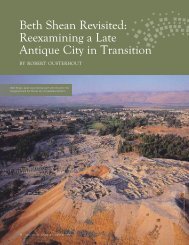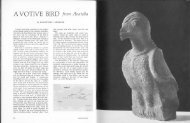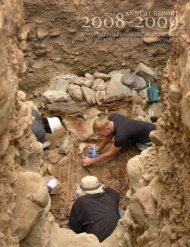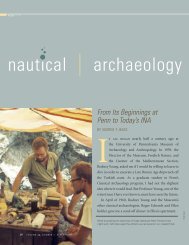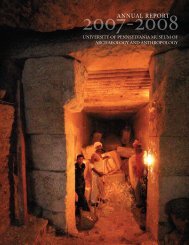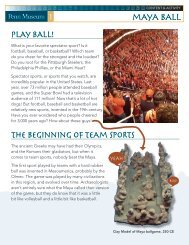ancient egypt's - University of Pennsylvania Museum of Archaeology ...
ancient egypt's - University of Pennsylvania Museum of Archaeology ...
ancient egypt's - University of Pennsylvania Museum of Archaeology ...
Create successful ePaper yourself
Turn your PDF publications into a flip-book with our unique Google optimized e-Paper software.
6<br />
AMARNA<br />
ANCIENT EGYPT’S<br />
PLACE IN THE SUN<br />
EGYPT’S TRADITIONAL GODS<br />
Amun Re<br />
Amun Re was the sun god. He was the king <strong>of</strong> the gods,<br />
and was created when the idea <strong>of</strong> two separate gods,<br />
Amun and Re, became one over time. Amun means<br />
“the hidden one,” and represents a power that is<br />
everywhere in the universe, but cannot be seen. Re<br />
represents the sun as it appears in the sky, and was<br />
most <strong>of</strong>ten shown as a man with a ram’s head<br />
crowned by the sun. Over time, Amun Re<br />
became thought <strong>of</strong> as the chief <strong>of</strong> the gods.<br />
During the New Kingdom he became even<br />
more important, and people believed that he was<br />
the source <strong>of</strong> all other gods, and the only force <strong>of</strong><br />
creation in the universe. During this period and the<br />
Amarna period Egyptians came closer to the practice<br />
<strong>of</strong> monotheism, or the worship <strong>of</strong> only one god, than<br />
they ever had before.<br />
Amun Re was important to all Egyptians, from the<br />
pharaoh to the most common person. Myth said<br />
that Amun Re was the pharaoh’s father, and that<br />
he ruled Egypt through the pharaoh. Yet this god<br />
was not only concerned with politics and powerful<br />
people. Normal Egyptians were free to worship<br />
him and to ask him for help, because he was concerned<br />
with order and justice in the universe, from<br />
the largest to smallest detail.<br />
The Aten<br />
The Aten was the round sun as you see it in<br />
the sky. Unlike other Egyptian gods, the Aten<br />
was never shown as a person or animal: its<br />
only image was the sun, sometimes carved<br />
with hands extending downward as rays. This<br />
god existed before the Amarna period, but it<br />
was Akhnaten who made the Aten the only<br />
god worshipped in Egypt. This was a huge<br />
change for the people <strong>of</strong> Egypt. Before Amarna,<br />
all people in Egypt could worship any <strong>of</strong> the close to 2,000<br />
small and large gods <strong>of</strong> Egyptian myth. When Akhenaten<br />
made the Aten the only god, he also made it a god that only<br />
the pharaoh and his family could worship or communicate<br />
with. Egyptian people’s only connection with the Aten was<br />
through the pharaoh.<br />
Osiris<br />
Osiris was the god <strong>of</strong> the dead. A former king, he was<br />
betrayed, killed, and cut into pieces by his evil brother, Seth.<br />
Their sisters Isis and Nepthys found the pieces <strong>of</strong> the body and<br />
put the pieces back together as a mummy. Osiris is drawn as a<br />
mummy with arms crossed. Isis also became the wife <strong>of</strong> Osiris,<br />
and had a son with him named Horus. When Seth heard <strong>of</strong><br />
Horus he searched for him to kill him, but Isis hid him until<br />
he was old enough to challenge Seth. A long battle followed,<br />
but Horus finally beat Seth and became king. When Horus<br />
became king, Osiris came too his position as king <strong>of</strong> the dead.<br />
Instead <strong>of</strong> this being a sad job, Osiris was viewed as a peaceful<br />
god who held the possibility <strong>of</strong> eternal life for <strong>ancient</strong><br />
Egyptians.<br />
Isis<br />
Isis was the goddess sister and wife <strong>of</strong> Osiris. She appears in<br />
drawings as a beautiful woman holding an anhk, a symbol <strong>of</strong><br />
life. Her work healing Osiris and her devotion to her son Seth<br />
made Isis a very popular goddess who was worshipped in<br />
Egypt and throughout north Africa. She was the most widely<br />
worshipped <strong>of</strong> all the Egyptian goddesses.<br />
Horus<br />
Horus was the son <strong>of</strong> Osiris and Isis. He defeated his father’s<br />
killer, Seth, and became a king <strong>of</strong> Egypt. Horus was god <strong>of</strong> the<br />
sky. Like Amun Re, he was also a god <strong>of</strong> kings.<br />
Statue <strong>of</strong> Sekhmet, Thebes (Ramesseum), Dynasty 18, reign <strong>of</strong> Amenhotep III (1390-1353 BCE), granodiorite<br />
Sekhmet was a warlike and protective goddess. Her imagery <strong>of</strong>ten accompanied the pharaoh into battle. With her fiery arrows,<br />
she could send plagues and other diseases against her (and Pharaoh’s) enemies. The Egyptians also asked her to ward <strong>of</strong>f or cure diseases.<br />
Photo: Tom Jenkins.




